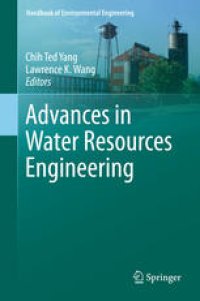
Ebook: Advances in Water Resources Engineering
- Tags: Waste Water Technology / Water Pollution Control / Water Management / Aquatic Pollution, Engineering Fluid Dynamics, Environmental Science and Engineering, Environmental Engineering/Biotechnology
- Series: Handbook of Environmental Engineering 14
- Year: 2015
- Publisher: Springer International Publishing
- Edition: 1
- Language: English
- pdf
This book, Advances in Water Resources Engineering, Volume 14, covers the topics on watershed sediment dynamics and modeling, integrated simulation of interactive surface water and groundwater systems, river channel stabilization with submerged vanes, non-equilibrium sediment transport, reservoir sedimentation, and fluvial processes, minimum energy dissipation rate theory and applications, hydraulic modeling development and application, geophysical methods for assessment of earthen dams, soil erosion on upland areas by rainfall and overland flow, geofluvial modeling methodologies and applications, and environmental water engineering glossary.
The Handbook of Environmental Engineering is a collection of methodologies that study the effects of pollution and waste in their three basic forms: gas, solid, and liquid. A sister volume to Volume 15: Modern Water Resources Engineering, this volume focuses on the theory and analysis of various water resources systems including watershed sediment dynamics and modeling, integrated simulation of interactive surface water and groundwater systems, river channel stabilization with submerged vanes, non-equilibrium sediment transport, reservoir sedimentation, and fluvial processes, minimum energy dissipation rate theory and applications, hydraulic modeling development and application, geophysical methods for assessment of earthen dams, soil erosion on upland areas by rainfall and overland flow, geofluvial modeling methodologies and applications, and an environmental water engineering glossary. This critical volume will serve as a valuable reference work for advanced undergraduate and graduate students, designers of water resources systems, and scientists and researchers.